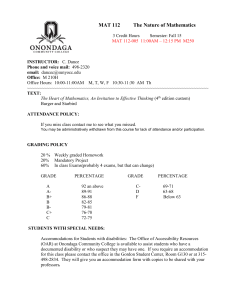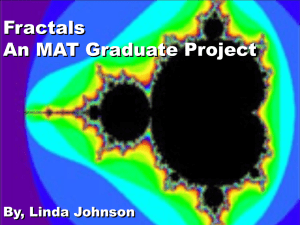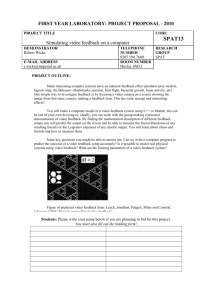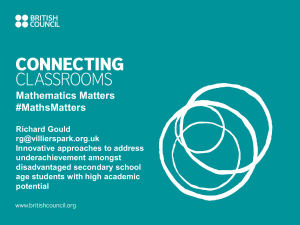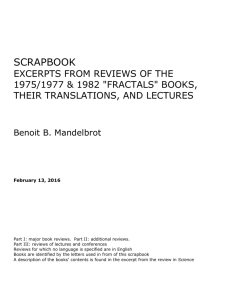Level 2 Mathematics and Statistics internal
advertisement
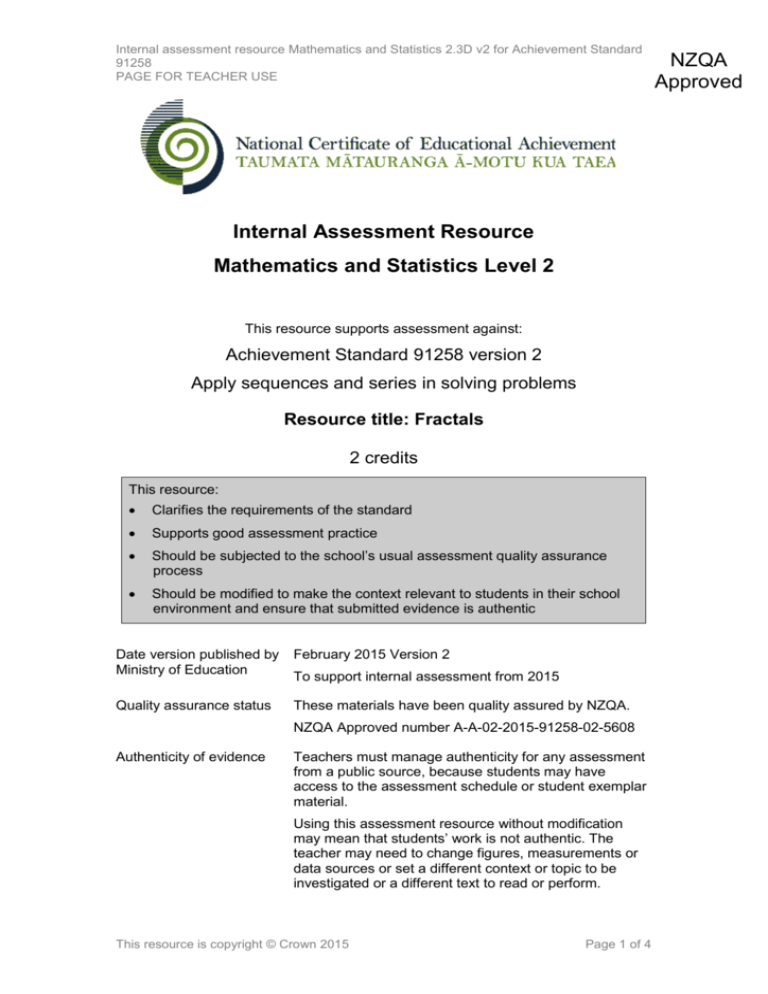
Internal assessment resource Mathematics and Statistics 2.3D v2 for Achievement Standard 91258 PAGE FOR TEACHER USE Internal Assessment Resource Mathematics and Statistics Level 2 This resource supports assessment against: Achievement Standard 91258 version 2 Apply sequences and series in solving problems Resource title: Fractals 2 credits This resource: Clarifies the requirements of the standard Supports good assessment practice Should be subjected to the school’s usual assessment quality assurance process Should be modified to make the context relevant to students in their school environment and ensure that submitted evidence is authentic Date version published by Ministry of Education February 2015 Version 2 Quality assurance status These materials have been quality assured by NZQA. To support internal assessment from 2015 NZQA Approved number A-A-02-2015-91258-02-5608 Authenticity of evidence Teachers must manage authenticity for any assessment from a public source, because students may have access to the assessment schedule or student exemplar material. Using this assessment resource without modification may mean that students’ work is not authentic. The teacher may need to change figures, measurements or data sources or set a different context or topic to be investigated or a different text to read or perform. This resource is copyright © Crown 2015 Page 1 of 4 NZQA Approved Internal assessment resource Mathematics and Statistics 2.3D v2 for Achievement Standard 91258 PAGE FOR TEACHER USE Internal Assessment Resource Achievement Standard Mathematics and Statistics 91258: Apply sequences and series in solving problems Resource reference: Mathematics and Statistics 2.3D v2 Resource title: Fractals Credits: 2 Teacher guidelines The following guidelines are designed to ensure that teachers can carry out valid and consistent assessment using this internal assessment resource. Teachers need to be very familiar with the outcome being assessed by Achievement Standard Mathematics and Statistics 91258. The achievement criteria and the explanatory notes contain information, definitions, and requirements that are crucial when interpreting the standard and assessing students against it. Context/setting This assessment activity requires students to create a fractal and use sequences and series to investigate their shape. Teacher note: If the teacher resources on fractals that have been developed are used, the students will need to choose a fractal other than the Koch curve and the Sierpinski triangle or design their own for this activity. Teachers need to ensure that the features the students select allow sufficient investigation to meet the standard. Conditions This activity is designed to be an investigative task. It is not intended to be a one lesson in class assessment. Confirm the timeframe with your students. Students need to work independently. Students may use graphing calculators, spreadsheets or similar technology. Resource requirements Provide students with a copy of the Level 2 Mathematics formulae sheet. Additional information Teaching resources on fractals are available from http://seniorsecondary.tki.org.nz/Mathematics-and-statistics/Learning-programmedesign/Year-12-programme-design/Level-7-mathematics-and-statisticsexample/Activity-Fractals#experiences . This resource is copyright © Crown 2015 Page 2 of 4 Internal assessment resource Mathematics and Statistics 2.3D v2 for Achievement Standard 91258 PAGE FOR STUDENT USE Internal Assessment Resource Achievement Standard Mathematics and Statistics 91258: Apply sequences and series in solving problems Resource reference: Mathematics and Statistics 2.3D v2 Resource title: Fractals Credits: 2 Achievement Achievement with Merit Achievement with Excellence Apply sequences and series in solving problems. Apply sequences and series, using relational thinking, in solving problems. Apply sequences and series, using extended abstract thinking, in solving problems. Student instructions Introduction This assessment activity requires you to create a fractal and use sequences and series to investigate features of the shape. Features of fractals include such things as length, area, number of items, volume. Working independently you will: hand in a plan of what your fractal is and the features you are going to investigate present your findings in a form that could be, but is not restricted to, a presentation or a written report. Task Create your own fractal. Include: Details of how the fractal is created, i.e. the initial unit segment or shape, and how your fractals are formed, including diagrams. The values generated for at least three stages (after the initial stage) of the fractal for at least two of the features of the fractal. The totals for at least two features of the fractal for any given stage. Describe what will happen to the values and totals for each feature as the number of iterations increases. For your chosen features, will there be a point where the next iteration makes no significant difference to the feature? Describe the conditions under which this might happen. The quality of your reasoning and how well you link this context to generalisations of arithmetic and geometric sequences will determine the overall grade. Include calculations, diagrams or formulae, as appropriate. Clearly communicate your method using correct mathematical statements where appropriate. This resource is copyright © Crown 2015 Page 3 of 4 Internal assessment resource Mathematics and Statistics 2.3D v2 for Achievement Standard 91258 PAGE FOR TEACHER USE Assessment schedule: Mathematics and Statistics 91258 Fractals Evidence/Judgements for Achievement Evidence/Judgements for Achievement with Merit Evidence/Judgements for Achievement with Excellence The student has applied sequences and series in solving problems. The student has applied sequences and series, using relational thinking, in solving problems. The student correctly selects and uses sequences and series. They have demonstrated knowledge of concepts and terms and have communicated using appropriate representations. The student has selected and carried out a logical sequence of steps or formed and used a model and related their findings to the context or communicated their thinking using appropriate mathematical statements. The student has applied sequences and series, using extended abstract thinking, in solving problems. The student used their fractal designs to identify values and/or totals for identified features of the fractals. For example: The student correctly calculates a specific value for a feature (must be for at least the third iteration after the initial stage) The student correctly calculates the total for a feature (must be for at least three iterations after the initial stage) The student has correctly found the number of iterations required to meet a specified criteria. The student has developed a chain of logical reasoning or has formed a generalisation and has used correct mathematical statements or communicated mathematical insight. For example For example The student forms the model for the general term for a value of a feature and uses it to find the value of that feature for a specific iteration. The student forms the model for the sum to infinity for the values of a feature and uses it to find the sum to infinity for the values of that feature. The student has identified suitable conditions for an additional iteration such that the difference for the feature is negligible and has used this to identify at which iteration this might occur. Final grades will be decided using professional judgement based on a holistic examination of the evidence provided against the criteria in the Achievement Standard. This resource is copyright © Crown 2015 Page 4 of 4
